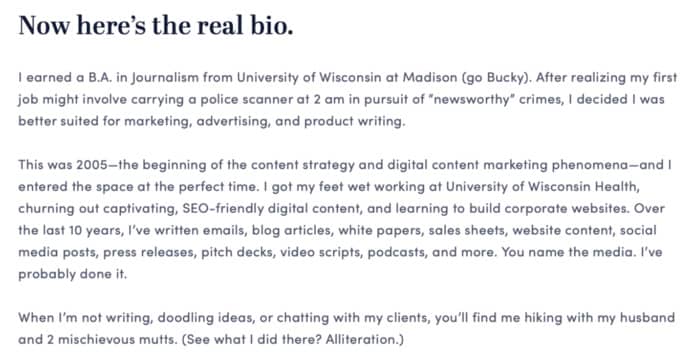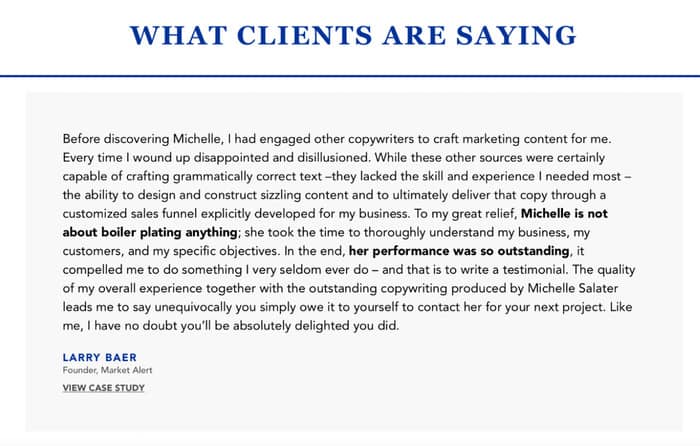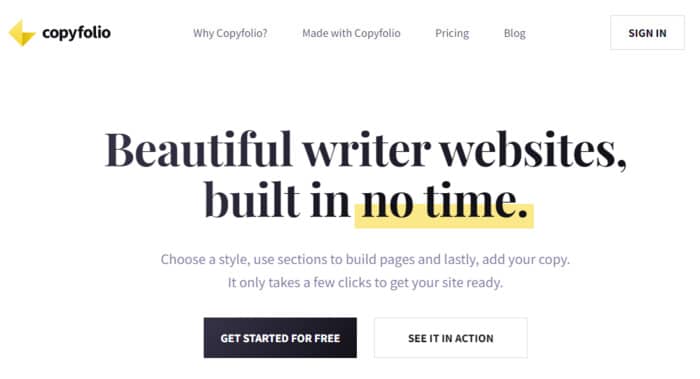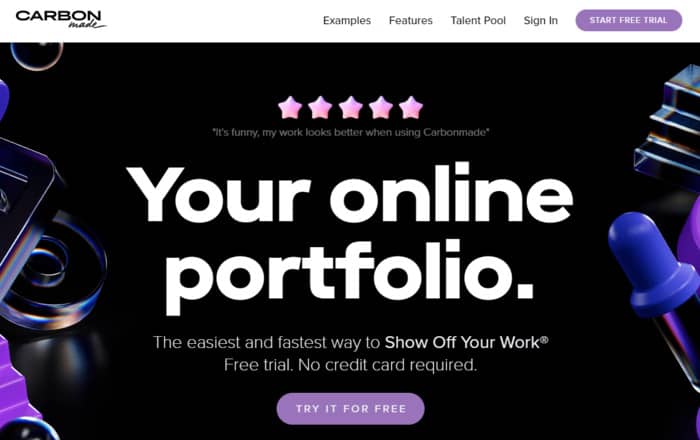Every aspiring copywriter needs an eye-catching professional copywriting portfolio that puts their best foot forward and gets clients.
The question is, how do you create one?
In this post I’m going to show you how to create a winning copywriting portfolio that’ll have you on the road to success before you know it.
As a freelance copywriter, I’ve done it myself.
First, I wrote some samples. No client employed me to write them – I just made them up for fictional businesses.
Next, I loaded those samples into Google Docs.
And then finally, I created a simple website with by photo and links to the Google Docs.
As I get testimonials from clients, I’ll add them, but for now, what I have is enough for me to get copywriting jobs.
It’s that simple.
While creating a portfolio that dazzles people with your copywriting skill may seem daunting at first, it’s remarkably easy once you get the hang of it.
And believe it or not, as a copywriter, you already have the necessary skills to pull it off.
But before we go any further, we need to talk about…
Why You Need a Copywriting Portfolio
The short answer is that you need a quick and easy way to show potential clients that you can write persuasive copy.
The portfolio doesn’t have to cost a lot of money or take a lot of time to create either.
If you are time-challenged, or just want to start beating the bushes as quickly as possible, you can whip up an impressive copywriting portfolio on your lunch hour that’ll get the job done.
Having said that, you still need to do it right. Your copywriting portfolio is THE most important sales piece you’ll ever create (no pressure there, huh?).
While having a copywriting portfolio is not absolutely necessary to find work, not having one will definitely hold you back.
And a poorly crafted one will kill your copywriting career before it even starts.
The key to creating a winning copywriting portfolio is to… think like a copywriter!
You already have the ability to write persuasive sales copy, right? This time, however, the product you’re selling is you.
I understand that selling ourselves can be uncomfortable. Putting ourselves out there doesn’t come easy to many people. I assure you, however, it gets easier the more you do it.
With that in mind, let’s put on our copywriter’s hat and get to work…
How To Create a Copywriting Portfolio (+ Examples)
If you’re just starting out, don’t worry about your portfolio being perfect. It’s not going to happen no matter how hard you try.
Accept it.
Your portfolio will become more polished over time.
The immediate goal is to create a “minimum viable product” (or MVP for short), get your name out there and show prospective clients what you can do.
Your writing samples can be as few as one piece. Work with what you have. You can add to it later.
Also, don’t settle on a niche too soon. Be open-minded about the projects you accept. Get some wins under your belt.
Show prospects that you can write web copy, sales pages, or ad copy for a variety of niches.
What Every Potential Client Wants to Know
Everybody is busy nowadays. Attention spans are at an all-time low and getting shorter by the minute.
Your writing portfolio must immediately grab their attention and answer the following questions:
- Do you have the writing style they want?
- Have you worked with businesses like theirs before?
- Are you the type of person they want to work with?
As a copywriter, it’s up to you to figure out how to address the above concerns as effectively as possible
Every Copywriting Portfolio Must Have These Things
Below are some ideas (and examples) to get the creative juices flowing. Never forget, however, that your portfolio is more than a summary of your past work and some contact information.
Put some personality into it. What works for one person may not be right for you. The client is hiring a human being, not a robot.
1. First Impressions Mean Everything
People need to connect a name to a face. Make sure your profile photo is a quality headshot. Smile. Comb your hair. Look friendly. Try to come across as someone a stranger would want to get to know better.
Business casual dress is preferred. For most situations, a suit and tie will probably look too formal, unless your eventual target audience is lawyers or something similar. Even then, a simple collared shirt will work fine.
To show you what I mean, here is a great example. Notice in the photo below how Jennifer Locke conveys warmth and friendliness.

She comes across as approachable and inviting. Presentable without being formal.
Your photo should communicate similar emotions.
2. State Your Value Proposition Clearly
Notice how Curaytor gets to the point immediately. The value proposition is clear, concise and gets right to the point.

Here’s where your copywriting skills need to shine.
Look at how they address what is most likely the prospective client’s biggest pain point immediately.
You should look to do the same.
3. Write A Short (But Sweet) About Me Page
Your About Me page doesn’t have to be long.
In fact, brevity is best.
It needs to be just long enough to cover the subject, but short enough to retain interest.
Look at Emily Thompson’s About Me page:

She gives a basic overview of who she is in an easy-to-read manner without dragging it out.
5. Let Your Testimonials Shine
Michelle Salater isn’t shy about letting the world know about her satisfied clients. Neither should you.

If you’ve done a good job for someone, get it in writing. The more people that sing your praises, the better.
Whatever you do, however, don’t make them up. Honesty is always the best policy.
In some cases, however, you may have to write the testimonial for busy clients. That’s fine. Just make sure they approve the wording.
6. Give Them a Strong (and Clear) Call To Action
Make sure your Call To Action is clear and lets people know exactly what you want them to do.
A confused reader always says “No.”
The Call To Action is a great time to restate your value proposition and create a sense of urgency.
TheWriteLens provides a good example:

In addition to a button, consider including a phone number. Make it easy, Give them options.
What Kind of Samples Should You Show?
Only include your best content and the type of copywriting projects you want to do. If you wrote product descriptions in the past and hated it, don’t put them in your portfolio.
When presenting samples of your writing, include as many project details as possible. Give some context. How was the client better off for your efforts? What challenges did they face? How did you overcome them?
Things like that.
If you helped increase sales by 17.4% or customer satisfaction by 39.6%, say so. Be specific. You want to come off as someone committed to getting results.
In the beginning, you may have to write about fictional products and companies to show your skills. That’s fine. Just be upfront about it.
Of course, as a copywriter, you know this already, but it bears repeating anyway – write tight, concise copy that stresses benefits and highlights your Unique Selling Proposition.
5 Ways to Publish Your Copywriting Portfolio
You have two options.
- Build a personal portfolio website and learn a lot of new things: themes, plug-ins, on-page SEO, hosting, and all the other moving parts. Or pay someone to manage those details for you.
- Use a done-for-you tool (some with free versions) and/or free social media platforms.
Even if you know website technology like the back of your hand, it’s not necessary to have a personal website to get clients when you’re starting out.
The initial set-up and ongoing costs of operating a personal website need to be considered as well. The negative cash flow can add up in a hurry.
A beginner’s time is best spent pitching clients, writing copy, and building a business, not tinkering with websites and figuring out (or paying someone) how to solve the problems that will inevitably crop up.
Many successful copywriters have built thriving businesses using nothing but done-for-you tools and free social media accounts.
You can too.
With that in mind, let’s explore some of the best options to get you started.
1. Copyfolio

Copyfolio is a portfolio builder tool that has a free version, as well as a paid one.
The free version gets you one website template, case study writing tips, one public project, three website pages, and access to mock-ups.
The navigation is easy and Copyfolio walks you through the entire set-up process. You can get up and running in no time.
The paid version is more robust. In addition to what’s available on the free version, you also get:
- unlimited public projects
- unlimited website pages
- exclusive sections
- designer color & font presets
- no Copyfolio branding
- custom domain & URL slug
The paid version is $15 a month, if you go that route, or $9 a month if you choose the yearly plan.
Here are some examples of Copyfolio’s writer’s sites.
2. Weblium

Weblium is a traditional website builder that can also be used by a freelance copywriter. It contains a few more moving parts than Copyfolio, but nothing overly complicated. Many of the additional features may prove to be helpful to your marketing.
If you aren’t graphically-inclined, you may find the AI design tool helpful.
The free version gets you:
- 300+ Ready-T-Use Templates
- AI-Powered Design Assistance
- Unlimited Storage
- SSL Certification
If you want to pay $15 a month for the monthly plan, or $8.25 a month for the annual plan, you get all the free features plus:
- Free Domain for a year
- Google Analytics Integration
- No Weblium Ads
- Custom Code Integration
- SEO Indexing
Here are some examples of websites built by Weblium.
3. Carbonmade

When a copywriter first goes to Carbonmade, it’s easy for them to think they’re in the wrong place.
They’re not.
Carbonmade is a portfolio builder tool that’s ideal for creatives (including copywriters) that want a more customized look that reflects their unique voice and personality.
It comes in three different pricing levels:
- Beginner: $9/month, or $99 for the annual plan – 8 Projects
- Pro: $12/month, or $119 for the annual plan – 50 Projects
- Unlimited: $22/month, or $199 for the annual plan – Unlimited Projects
The most interesting feature of this option is its free trial program. They won’t start charging you until you’re ready to go live.
Here are some of the examples of Carbonmade portfolios.
4. LinkedIn

Every marketing professional needs to be on LinkedIn.
Besides being the go-to forum for making connections and marketing your services, LinkedIn allows you to share samples of your work with the people most likely to hire you.
For more information about how to upload your copywriting portfolio onto LinkedIn, click here.
5. Other Social Media Platforms
Twitter, Facebook, Pinterest, and Instagram have their pros and cons as online portfolio tools. They all pale in comparison to LinkedIn, but many copywriters have found ways to use them successfully.
Once you get your LinkedIn portfolio up and running, it wouldn’t hurt to play around with the others and experiment. You may find opportunities to get your portfolio in front of the right people.
Ready to Build Your Copywriting Portfolio?
In the end, a copywriting portfolio is only a tool, not a magic bullet. It needs to be a part of an overall marketing strategy.
While having a portfolio with high-quality samples can help get people to notice your talent, it can’t close the deal. Only you can do that.
Nevertheless, if you follow the guidance given above, you’ll be well on your way towards creating a winning portfolio that gets results and being a highly-paid professional copywriter!





